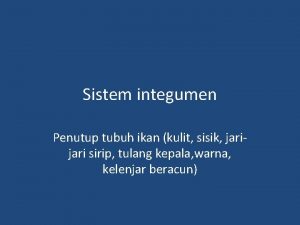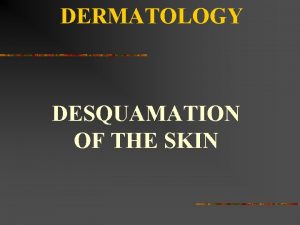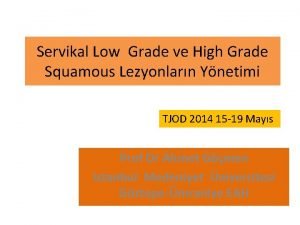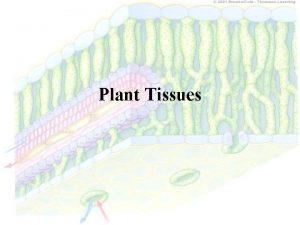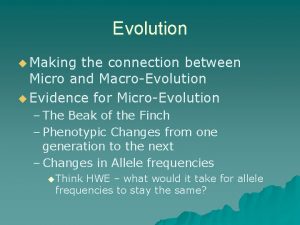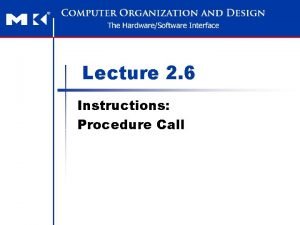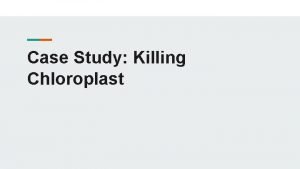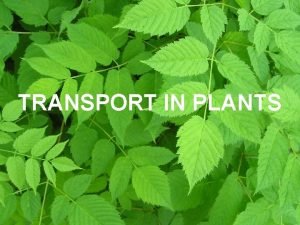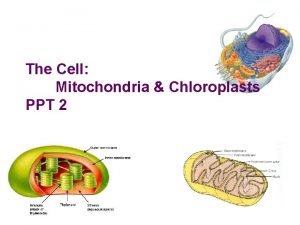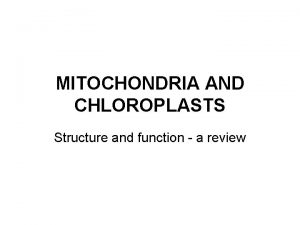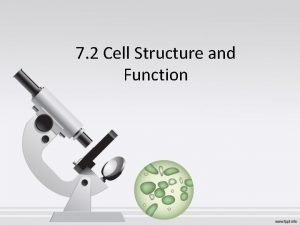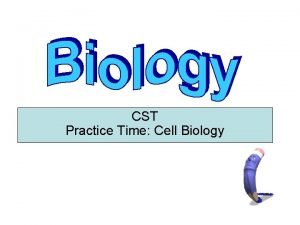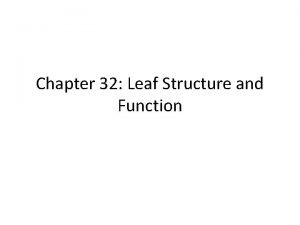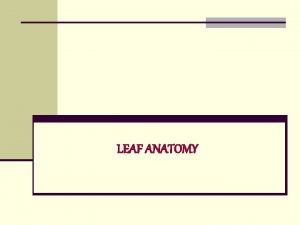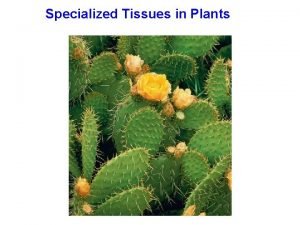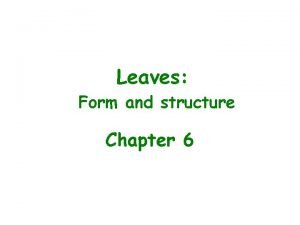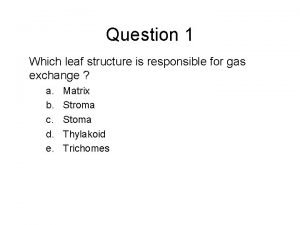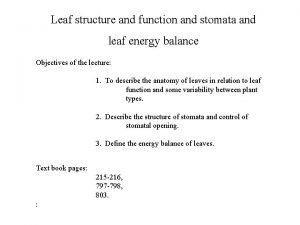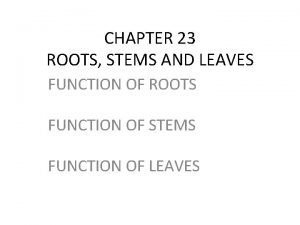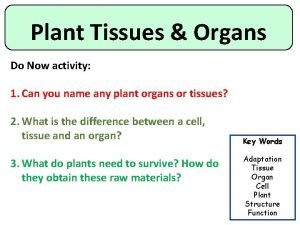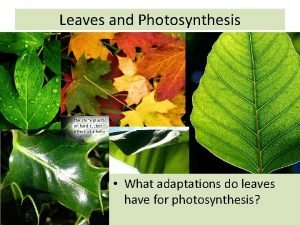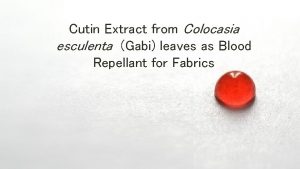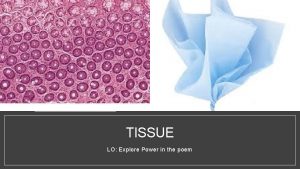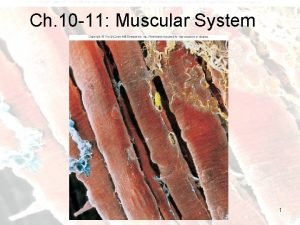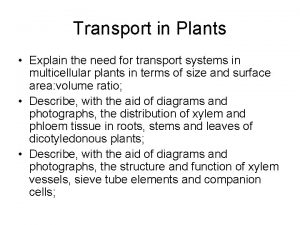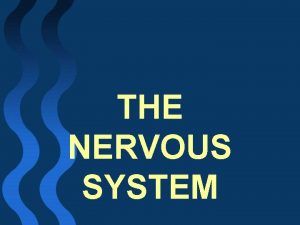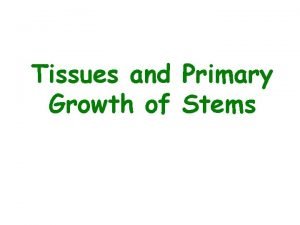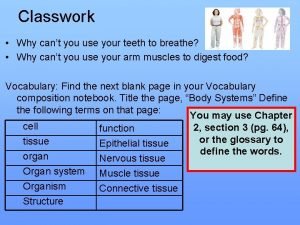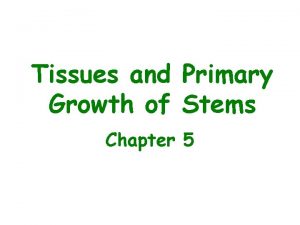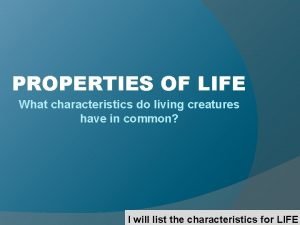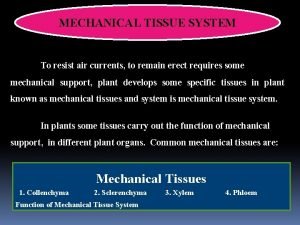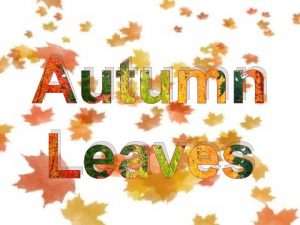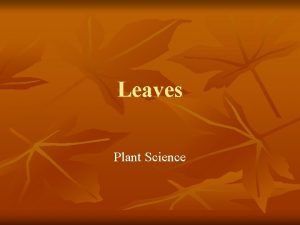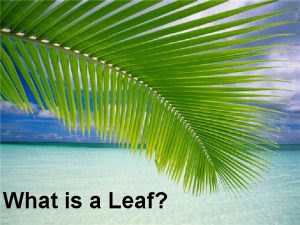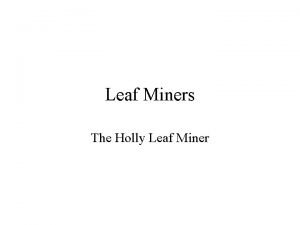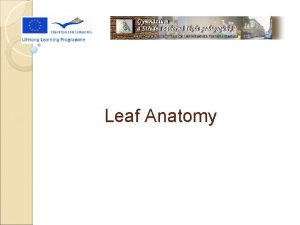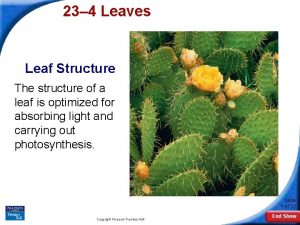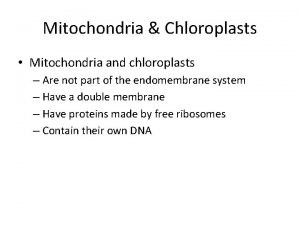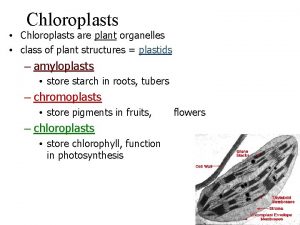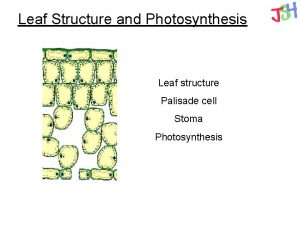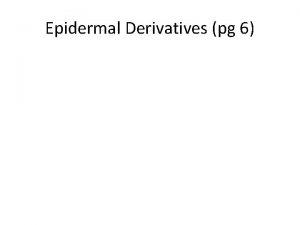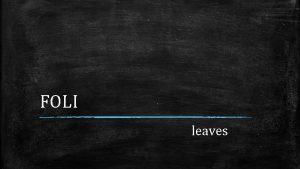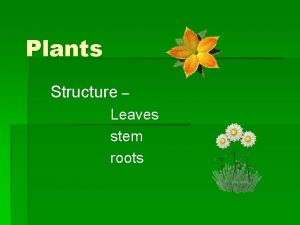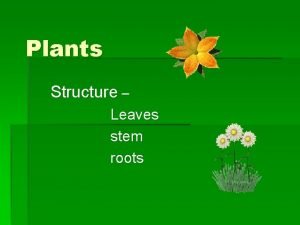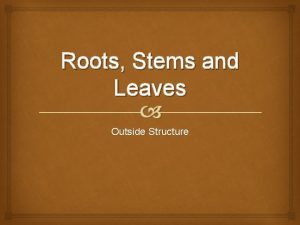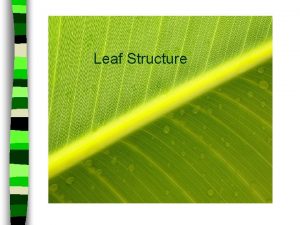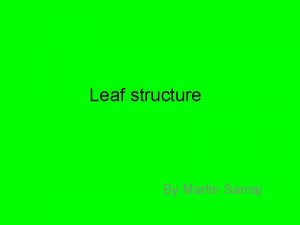Leaves Leaf Structure Epidermal tissue system chloroplasts only













































- Slides: 45

Leaves

Leaf Structure • Epidermal tissue system – chloroplasts only in guard cells • Ground tissue system – mesophyll • Vascular tissue system • Leaf adaptations – sun and shade leaves – xerophytes

Photosynthesis sunlight, water CO 2 Dark reactions (Calvin cycle) Light reactions Oxygen (O 2) Glucose (C 6 H 12 O 6) (carbohydrates)

Start with the Big Picture • It’s all about energy – potential vs kinetic energy • Nearly all energy used on earth comes from the sun • Nearly all energy used on earth ends up as heat • Metabolism – the way living things manage energy

Laws of Thermodynamics • Energy can neither be created nor destroyed but it can be converted from one form to another • In any transfer of energy there is always loss of useful energy, usually as heat

What makes chemical reactions happen? • Chemical bonds have potential energy • When the bonds are broken, the energy is released • Cells transfer energy from one molecule to another, often as a proton (H+) or electron (e-) • Enzymes are proteins that speed up chemical reactions • ATP has high-energy phosphate bonds • ATP bonds come from glucose • Glucose comes from. . .

Metabolism summary • Photosynthesis – light reactions – dark reactions • Respiration – glycolysis – Krebs cycle – electron transport – fermentation Solar energy captured in chemical bonds Chemical bond energy is released to do work


Photosynthesis CO 2 sunlight, water Thylakoid membrane Dark reactions (Calvin cycle) ATP, NADPH Light reactions Chloroplast stroma oxygen Glucose (C 6 H 12 O 6) (carbohydrates)

Movie

Light Reactions of Photosynthesis • Chlorophyll is a pigment in the thylakoid membrane • It can absorb light energy • The absorbed energy knocks an electron out Movie 1 of the chlorophyll molecule • This electron is transported from one molecule to another • The energy is used to make ATP Movie 2 • The original electron is replaced with one from a molecule of water, releasing O 2

A good summary. . .

Dark Reactions (Calvin cycle) • Occurs in the stroma of the chloroplast • CO 2 diffuses into spongy mesophyll cells • RUBISCO is the enzyme that fixes the CO 2 into a carbon compound – it’s the most abundant protein on earth – a very complicated enzyme!

Rubisco


Calvin cycle Movie

The atmosphere contains oxygen because of photosynthesis

Oxygen causes a problem for RUBISCO • RUBISCO binds O 2 as well as CO 2 – the substrates compete for the active site • O 2 results in no new sugar • Some plants have evolved a way to avoid this wasteful reaction



Some C 4 plants






ATP <


Water molecules Waterbox <

Companion cells Sieve cells <




End of Show

Dicot leaf surface Monocot leaf surface


Palisade parenchyma Xylem Stoma Lower epidermis Phloem Upper epidermis Spongy parenchyma

Sun leaf and shade leaf sections Genetic vs environmental differences in leaves


Xerophytes are plants that grow in dry conditions

What are the adaptations to dry conditions?

Leaf cross section Which tissue holds the water?

Net or pinnate venation (dicots) Parallel venation (monocots)

Typical horizontal leaf Typical vertical leaf

 Epidermal tissue system
Epidermal tissue system Penutup tubuh lele
Penutup tubuh lele Fimmta veikin
Fimmta veikin Hpv pozitif smear negatif
Hpv pozitif smear negatif Monocot petiole
Monocot petiole Maple leaf and oak leaf homologous
Maple leaf and oak leaf homologous Leaf and non leaf procedure
Leaf and non leaf procedure Killing chloroplast case study
Killing chloroplast case study Why root hair cells do not contain chloroplasts
Why root hair cells do not contain chloroplasts Respiration mitochondria
Respiration mitochondria Chloroplast structure and function
Chloroplast structure and function Mitochondrial vesicles
Mitochondrial vesicles Which two protists contain chloroplasts
Which two protists contain chloroplasts A cell with numerous ribosomes is probably specialized for
A cell with numerous ribosomes is probably specialized for Which hose roll leaves only one coupling exposed?
Which hose roll leaves only one coupling exposed? Jaringan epitel dapat ditemukan di
Jaringan epitel dapat ditemukan di Leave only footprints take only photos
Leave only footprints take only photos Structure of leaf
Structure of leaf Upper epidermis function in photosynthesis
Upper epidermis function in photosynthesis Leaf cells
Leaf cells Stoma function
Stoma function Transpiration in plants
Transpiration in plants Leaf structure questions
Leaf structure questions Stomata in leaves
Stomata in leaves Leaf structure cube
Leaf structure cube Leaf structure diagram
Leaf structure diagram . what are the adaptations of leaf for photosynthesis?
. what are the adaptations of leaf for photosynthesis? Gabi leaves protective structure
Gabi leaves protective structure Tissue poem structure
Tissue poem structure Skeletal muscle tissue structure
Skeletal muscle tissue structure Xylem vessels
Xylem vessels Nervous tissue structure
Nervous tissue structure Tissue system in plants
Tissue system in plants Cell tissue organ organ system organism
Cell tissue organ organ system organism Tissue are grouped together to form various
Tissue are grouped together to form various Cardiorespiratory system includes
Cardiorespiratory system includes Label the different types of neuronal pools in the figure.
Label the different types of neuronal pools in the figure. Daun
Daun Primary growth
Primary growth Cell tissue organ system body
Cell tissue organ system body Mechanical tissue system
Mechanical tissue system Sensory input and motor output
Sensory input and motor output Processes of neuron
Processes of neuron What are the 3 newton laws
What are the 3 newton laws Earth is a closed system
Earth is a closed system Respiratory system circulatory system digestive system
Respiratory system circulatory system digestive system

